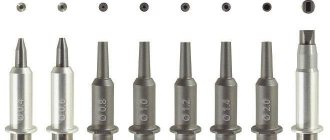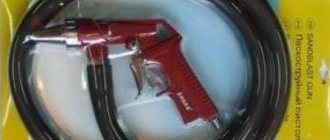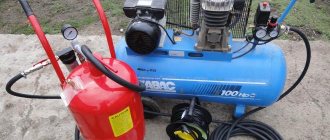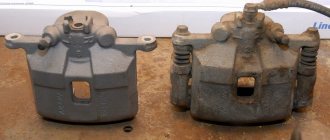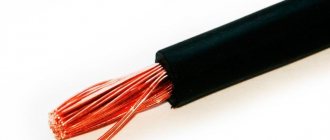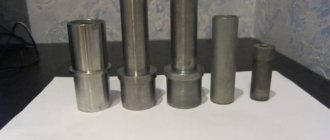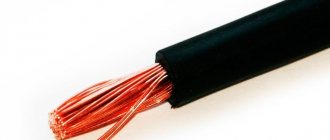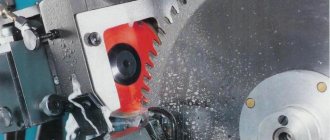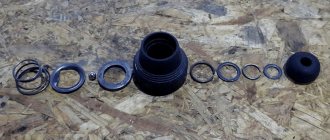Abrasive particles fly through the nozzle of sandblasting machines under high pressure to clean the surfaces being treated. The abrasive actively acts on foreign substances that need to be removed. Also, this working flow is aggressive to the inner diameter of the nozzle.
Therefore, nozzles are consumables and must be replaced regularly. For industrial installations, replacement nozzles can be purchased through service. But today there are homemade and factory-made installations for small workshops. For them, many craftsmen make nozzles themselves from used spark plugs of gasoline internal combustion engines.
sandblast gun resuscitation
Thanks for the information, it's spot on.
Great! I can’t get around to picking up a sandblaster myself. Either I’m afraid of this very wear and tear, or I simply have nothing to grab onto. We have YATO for sale, it seems like the company is not completely crappy, but the nozzles there are somehow not very comfortable. In terms of what will have to be changed, and where to get spare ones? Sharpening them is not very convenient. And there are some inexpensive pistols that I don’t really like. But the nozzles are simple, it makes you laugh. So I won’t buy it at all.
But does such a “candle” nozzle last long? Or even eternal?
just about a month ago I threw about 10 old spark plugs out of the car... in principle, everything is clear, I will try, especially since the need for sandblasting arises from time to time... THANK YOU!
Originally posted by TOPIC Minsk:
But does such a “candle” nozzle last long? Or even eternal? [/QUOTEIf you are not going to clean five squares a day, then consider it eternal))))))
no, the gun is not homemade, slightly modified, destroyed by sandblasting.
By the way, it is certainly possible to use ceramic nozzles for argon welding as nozzles. They come in different sizes (I have seen hole diameters of 4,5,6,7,8mm). cost around 25-30 rupees. not a shortage.
The insulator uses aluminum carbide (if I’m not mistaken), which is resistant to abrasion, which is why I use them, but for welding I don’t know what kind of material it is. And the external diameter of the candle is suitable. But as an option, there is no need to exclude welding. Try it and tell me
so there's nothing to tell. I don’t have such a pistol. I just recently bought these nozzles for a welder and they stuck in my memory. They will be some kind of pinkish-red color. They are quite fragile, because when the splashes of metal are removed, they break easily. very heat resistant.
Making a sandblasting chamber
Before proceeding directly to the assembly, it is necessary to take into account a number of factors: draw up a competent drawing and description (one of the options will be presented below), select all the necessary components and decide on the location.
You always want your own sandblasting chamber to be as large as possible, but this will entail a number of consequences: you need a more powerful hood, as well as more durable materials for the body.
The sandblasting chamber is a metal box containing:
- holes for gloves;
- observation window;
- holes for supplying a hose for a gun;
- ventilation holes;
- viewing window;
- bottom grid on which the workpiece will lie;
- hopper for collecting waste abrasive and debris.
Assembly order
The sandblasting chamber assembly procedure includes several stages
It is important to follow their sequence, otherwise it may create some inconvenience and delay assembly. The material you will need is a corner with a shelf of 25-32 mm, galvanized steel 0.5 mm thick, impact-resistant plastic, rivets
The manufacturing procedure is as follows:
- We cut the corners according to the previously prepared drawing.
- Using welding, we assemble a frame from them.
- We attach a reinforced mesh as a bottom, on which the workpiece will be located. The mesh must be strong to support heavy products.
- We light from the two upper corners so that there are no shadows. This will allow you to work with greater comfort. The lighting should be bright enough, as there will be a lot of dust inside. It is worth remembering a little trick: if you choose white light, for example, neon lamps, with this spectrum the view will significantly deteriorate. It is better to use yellow, for example, incandescent lamps, or LED lamps with a suitable spectrum. The principle is the same as in fog lights, thanks to which you can distinguish something in bad weather.
- We place pre-cut sheets of metal on the sealant. It is necessary that one of the walls can be opened for inserting and removing parts and servicing the chamber from the inside.
- Additionally, we fasten the metal to the corners with rivets.
- Using scissors, we cut out the necessary hole in the metal for the ventilation mittens.
- For safety reasons, it is better to make the viewing glass from impact-resistant plastic rather than glass, since it is possible that abrasives (not only sand, but also metal balls) will be used in the chamber.
- The chamber must be equipped with a powerful hood (the more powerful, the better, at least 1500 liters per minute).
Safety precautions
Using a sandblasting chamber, like sandblasting without it, requires compliance with the same safety measures
It is important to wear safety glasses, and in the case of a sandblasting chamber, only a respirator is sufficient. A fully covered suit and closed shoes are required.
It is also important to remember the safety of others. It is advisable that the camera be installed in a separate room where no one will be present.
We saw that making sandblasting with your own hands is not so difficult. It is enough to have certain skills and a great desire. Thanks to such efforts, you can save a lot of money and make a worthy analogue of the factory options.
A sandblasting chamber will be an excellent assistant and addition to your device, since thanks to it, performing assigned tasks will become less harmful to health, more comfortable and, accordingly, productive.
Operating principles
Lada Largus we replace spark plugs in a 16-valve engine.
Largus spark plugs The sandblasting nozzle is attached to a holder - the end of the hose, with a union nut or clamp. The air flow, passing through the container with sand, captures it and delivers it through the hose to the nozzle. Passing through the nozzle, the mixture is evened out in its composition and increases speed. Coming out of the diffuser, sand particles hit the surface of the part at high speed, knocking out particles of dirt and old finishes.
When installing Chinese nozzles, you need to pay attention to the diameter and method of attachment. They mostly have clamps on them.
They are mainly suitable for equipment manufactured in the Middle Kingdom. On devices from other manufacturers, the nozzle is installed through an adapter.
The homemade device is short-lived. It can be used at pressures less than 6 atm. Ceramic inserts are made from candles by drilling out the electrode. Cast iron and steel are drilled. The surface of the hole is rough, sand slows down and at the same time wears out quickly.
In sandblasting equipment, in addition to sand, other abrasive elements are used: crushed glass, metal balls, ceramics.
A nozzle you make yourself will not last long. It will help out when repairing your own car or restoring furniture.
Features of choice
What to do if oil gets into spark plug wells
The main parameter for choosing a nozzle is the diameter of the nozzle hole. It depends on the operating mode of the sandblasting machine. The table shows approximate values of productivity and pressure depending on the diameter of the nozzle for a household sandblaster.
| Nozzle diameter, mm | Productivity, cubic meters m/hour | System pressure, atm | Sand consumption, kg/hour |
| 6 | 8–10 | 5 | 200–250 |
| 8 | 10–12 | 5–6 | 350–400 |
| 10 | 12–22 | 6–7 | 600–900 |
| 12 | more than 20 | 7–8 | 1000–1200 |
Industrial installations use nozzles larger than 12 mm.
The life of the nozzle depends on the material of the insert. An attachment made from a spark plug will last no more than an hour. This is enough for repair work in the garage. The service life of the steel nozzle is within 2 hours of continuous operation. Hard ceramics are destroyed during installation startup due to dynamic impact and uneven load. In addition to strength, the nozzle material requires high viscosity and abrasion resistance.
Nozzle inserts are made from different materials:
- high alloy steels;
- cast iron;
- ceramics;
- tungsten and boron carbide.
The cast iron insert can work up to 12 hours. Industrially produced tungsten carbide bits are suitable for use in workshops. Their service life depends on productivity and pressure, averaging 350 hours.
The most durable fluorine carbide inserts, capable of operating up to 1000 hours. At maximum loads, the nozzle can withstand 750 hours.
Industrial sandblasting machine
Checking work
When you first test the operation of a homemade nozzle, you may find that it does not work at all, works poorly or well. The former may occur if the hole is too small or the wrong abrasive is used - wet or coarse.
Craftsmen use homemade nozzles with a diameter of 2–4 mm. The abrasive must meet technological requirements. The quality of the work of a new part can be assessed in comparison, if previously a successfully working factory or home-made element was used, or by the result of the work.
The quality and performance of the entire installation depends on this small detail. In high-power industrial installations, factory-made nozzles are used, sometimes with complex geometry of the internal hole. In some models it is wider at the beginning and end, and narrower in the middle.
This allows you to create an increased working pressure of the abrasive powder at the outlet and at the same time ensures its free passage without blockages. In smaller installations, the use of homemade parts may be feasible. Based on experience, a ceramic candle nozzle lasts up to 50 working hours.
Source
Manufacturers
Toyota Sera 1.5 turbo 4WD Serafima Logbook MythBusters FHE connecting rods
Experts recommend nozzles from the following companies:
- Contracor - Russia;
- CLEMCO - Germany;
- VMZ - Velikoluksky Mechanical Plant.
German products are known for their reliable performance and long service life. Nozzles from CLEMCO are considered the best. The company produces mainly ceramic and tungsten carbide inserts.
Sandblasting nozzles from the Russian company Contracor are not inferior to them in quality. The main products are boron carbide, tungsten and ceramic inserts are available.
VSW produces conventional nozzles at a budget price. Hobbyists can purchase a variety of attachments - metal, ceramic and cast iron for one-time repairs.
What will you need?
Craftsmen recommend making nozzles from imported Champion and Brix candles with a long internal insulator. It is difficult to remove the core from domestic candles. It has extensions and small anchors for a strong connection to the ceramic. Therefore, when trying to pull out the metal core, the insulator often pricks. Such a candle is more reliable for its main use, but is less suitable for alterations.
Materials
In addition to the candle, you will need cutting discs for an angle grinder (grinder): for metal and diamond for concrete for cutting ceramics.
Tools
- A vice in which a candle is clamped.
- Angle grinder (grinder).
- Pliers.
- In some cases, a gas burner may be required.
How to choose a nozzle for a sandblaster
A nozzle with a Venturi profile allows you to increase the speed of movement of the sand-air mixture by 2.5...3 times compared to nozzles with a different internal hole configuration. A modern nozzle for a sandblasting machine with a Venturi profile is capable of ensuring the movement of particles at the outlet up to 700...720 km/h. At the same time, the cleaning performance at the same mixture flow rates and pressures increases approximately 2 times.
Approximately, the selection of nozzle parameters can be made according to the following criteria:
- In terms of performance. With the required installation productivity of up to 10...12 m3/h, the internal diameter of the nozzle does not exceed 8 mm, with 12...22 m3/h - 10 mm, with higher productivity values, the diameter of the internal channel should be 12 mm;
- According to the highest air pressure. If it does not exceed 5 at, then the channel diameter can be taken as 6...8 mm, at pressures up to 7 at - 8...10 mm, at higher pressures - 12 mm;
- Depending on the specific consumption of abrasive. If this parameter does not exceed 200...250 kg/h, then a nozzle with a diameter of 6 mm is suitable, at 350...400 kg/h - 8 mm, at 600...900 kg/h - 10 mm, in other cases - 12 mm.
These recommendations apply to nozzles with cylindrical internal holes. To recalculate the given data for a nozzle for a sandblasting machine with a Venturi profile, the data on processing productivity should be increased by 35...50%, on flow rate - by 60...75%, and on pressure - by 15...20%.
An important element of choice is the nozzle material. Conventional high-carbon steels with increased abrasive resistance (for example, steels of type 75 or 65G) are not suitable for these purposes, since when hardened to maximum hardness they are characterized by increased sensitivity to impact loads, which inevitably arise at the initial moment of feeding the abrasive mixture into the nozzle.
Ceramic compositions have even less durability. For example, when making a nozzle with your own hands, they often use a used spark plug from a car engine as a starting material, removing the metal casing from it. At the same time, they do not take into account that the ceramics in the spark plug design are designed to work with a gas flow in which there are no solid abrasive particles. Therefore, the durability of such hand-made ceramic nozzles does not exceed several hours.
More efficient is the option with carbide nozzles, which are made of tungsten carbide. The surface hardness of such products reaches 85...90 HRA, with a surface bending strength of up to 1400...1600 MPa. The disadvantage of such solutions is the high sensitivity of tungsten carbides to temperature. When the temperature rises to 80...100ºС (which is quite likely during long-term sandblasting), temperature cracks may appear on the surface of the nozzle. The durability of nozzles made of hard alloys reaches 750...800 hours.
The best option is to make a nozzle from boron carbide. With approximately the same hardness and strength, boron carbides are distinguished by their high resistance to temperature changes, therefore they retain their functionality at temperatures of 600...750ºС.
It is also interesting to compare prices for sandblasting nozzles. Industrial products made of boron carbide, depending on the length, profile and diameter of the internal hole, can be purchased for 1200...1600 rubles, and carbide nozzles - for 2500...7000 rubles.
Sandblasting: what types of nozzles are there?
An abrasive blasting nozzle is a device designed to create a directed air jet with abrasive. The main purpose of the abrasive blasting nozzle is to increase the flow rate of the abrasive-air mixture, forming a specific spray pattern and contact spot.
The length and shape of the internal channel of the nozzle, which determine the speed of the abrasive particles, are of great importance.
The optimal nozzle length is at least 10 times the diameter of the outlet and is usually in the range of 100-250 mm.
Selecting the right nozzle for a particular situation depends on a proper understanding of the different effects each type has on the cleaning behavior and cost of the job.
Materials from which nozzles are made
The choice of nozzle material determines its life, depending on the abrasive that is used, how often and how hard you work, and the working conditions. Nozzles are subject to very intense wear, which is influenced mainly by the material of the nozzle and abrasive, the speed of particle movement, and air pressure.
Removing spark plugs
WD40 will help you unscrew the spark plugs.
The spark plugs are dismantled with special spark plug wrenches for 14, 16, 18, 20, 22 millimeters. Some engines (usually 16-valve engines) require long spark plug wrenches because the spark plugs are located in deep spark plug wells. The spark plugs are unscrewed counterclockwise. Care must be taken not to drop anything unnecessary into the cylinder, otherwise trouble cannot be avoided. In general, it is better to cover the wells with a rag while cleaning the candles to avoid troubles.
During dismantling, it is a good idea to check the condition of the high-voltage wires. They should be soft and without cracks. Silicone wires have proven themselves to be the best. They are soft and do not tan in the cold.
The candles are tightened with a certain force. For a beginner, it is better to use a special torque wrench, tightening the spark plugs with the force regulated by the car manufacturer.
Causes and types of soot
A small amount of carbon deposits also forms during normal engine operation, but sometimes it forms abnormally quickly. There are several reasons for this:
- Incorrectly selected candles.
- Low quality fuel.
- High oil loss due to wear of the CPG.
- Fuel system malfunction.
- Rich air-fuel mixture.
- Incorrect ignition timing.
Types of deposits
By the appearance of soot, you can understand the reason for its formation. Black oily deposits indicate that oil has entered the combustion chamber. Dark brown soot indicates the fuel mixture is too rich. Whitish soot indicates a lean mixture. Red soot indicates the presence of tetraethyl lead in the fuel, a substance prohibited as an additive to modern motor gasoline. But, due to its low cost, it is often used by unscrupulous owners of gas stations to increase the octane number of fuel. The normal color of soot is considered to be light brown with a brick tint. Such deposits indicate that the engine is running on the correct fuel-air mixture. This mixture is called stoichiometric (the ratio of gasoline to air is 14:1 by weight). This mixture burns most completely, releasing less CO into the atmosphere, allows the engine to operate more economically and increases the life of the lambda probe and exhaust system.
Do-it-yourself sandblasting gun, including
- Buy or make it yourself?
- How to assemble a sandblasting gun yourself?
- Types of factory-produced sandblasting guns
A sandblasting gun can be an extremely useful and necessary tool for any business car owner. It is used for high-quality cleaning of various surfaces from foreign elements. With its help, metal parts are degreased and cleaned, old paintwork is removed, and traces of corrosion are eliminated. This does not require any effort. Sandblasting a part is much easier than trying to clean the metal with sandpaper with your own hands.
Buy or make it yourself?
Sandblasting guns can be found in any specialized store, so purchasing them will not cause any difficulties. Another thing is that not everyone will like the price of such a device. After all, good equipment is quite expensive, and economy class models can be unreliable in operation. In this case, the main selection criterion should be the compliance of the device parameters with the goals set. If the task is not to use sandblasting in large-scale production, then for domestic use it is quite possible to make a gun with your own hands.
Homemade sandblasting guns are assembled from a variety of available materials. The main principle for selecting parts is their performance characteristics. After all, the high abrasiveness of the working substance and the high feed speed create a rather aggressive environment for the elements of the gun and contribute to the rapid wear of its parts. Conventional sandblasting, as a rule, produces pressure from 4 to 10 atmospheres!
The good news is that to assemble the device with your own hands, you do not need to have a higher technical education or understand complex circuits. The simplest sandblasting device includes:
- handle;
- two fittings;
- nozzle.
How to assemble a sandblasting gun yourself?
Craftsmen use all kinds of household items for assembly: tees, ceramic nozzles from a dental machine, valves from spray guns. However, it must be borne in mind that the less durable materials you use, the shorter the service life of the manufactured device. A ceramic nozzle is unlikely to withstand more than three to four hours of intensive work, since it is not adapted to high abrasive loads. It is better to use a nozzle made of carbide alloys with boron or tungsten. This measure will increase the operating time of a home-made device tenfold.
The body of the device is machined to fit the size of the nozzle. Fittings and a handle are attached to it. To simplify assembly, you can use water fittings, a tee and a plastic bottle as a container for sand. It is attached to the top of the device. Sand is poured into it, then a hose from a compressor with compressed air is connected to the gun.
Types of factory-produced sandblasting guns
The design of sandblasters can vary greatly depending on the manufacturer, as well as on the factors that determine the features of their functioning. For example, there are models adapted for different methods of forming an abrasive mixture: with air or with water. In addition, the design may provide for various methods of supplying abrasive.
In accordance with this, they distinguish:
- Devices with a special tank. This model resembles a regular spray gun. With its help it is convenient to process small surfaces. For example, removing carbon deposits from spark plugs or oil stains from metal parts.
- Devices with hoses. In this version, two hoses are connected to the gun. One of them supplies compressed air, the other - abrasive material. Due to the absence of a bulky tank, such a device is more compact and suitable for treating hard-to-reach places.
In any case, no matter what device you choose, it will certainly be able to find its application in your garage. Expensive factory models will be more reliable. If you don’t want to spend large amounts of money, then you can easily assemble the device yourself.
Sandblasting from Karcher: nozzle for Karcher high pressure washer
A DIY sandblasting attachment used for installation on a standard Karcher machine will allow you to turn such equipment into a full-fledged sandblasting unit, useful in many situations.
Most Karcher washing machines operate under high pressure, so their technical capabilities are quite sufficient to supply sand through such a nozzle.
The difference between such a homemade device and a classic sandblaster will be that sand will be supplied through its nozzle along with water, but this is not critical for many situations.
Kärcher wet sandblasting kit
How does a sandblasting nozzle work?
The operating principle of any sandblasting installation is that abrasive material from a special hopper enters the nozzle under the influence of an air flow supplied under high pressure.
Cleaning candles at home
There are several ways to clean carbon from candles:
- Mechanical.
- Chemical.
- Ultrasonic.
- Combined.
How to remove carbon deposits from spark plugs mechanically
Spark plugs can be cleaned mechanically without any coatings of noble metals, such as iridium. For rough mechanical cleaning, a needle file and fine-grained sandpaper are suitable.
Burning candles on a gas burner
If the spark plugs are heavily soiled, they can be preheated on a gas burner until the thick oily carbon burns out.
Care should be taken not to overheat the spark plug insulator; allow it to cool in air to avoid cracking of the insulator
Some candles cannot be ignited. This will lead to their failure.
Large deposits on the skirt and electrode must first be cleaned with a needle file. Then sand with sandpaper until shiny. Mechanical cleaning can also be done using a solvent. White spirit will do. A hard brush or toothbrush is moistened with solvent. Then, carbon deposits are removed from the electrodes using circular movements. An iron brush used by welders in their work is also suitable for mechanical cleaning of carbon deposits. After cleaning the spark plugs mechanically, the recommended gap should be restored by bending the side electrode. The gap can also increase due to natural burnout of the electrode material during operation of the internal combustion engine.
Video: mechanical cleaning of candles with sand at home
How to clean spark plugs chemically: instructions
Dry cleaning
The chemical method is suitable for candles whose electrodes are coated with noble metals. For chemical cleaning of simple or iridium candles at home, household products for cleaning limescale and rust from sinks and bathtubs are perfect. Ordinary acetic acid, available in every home, is also a good remedy. It is better to use a 70% solution. Can be diluted with water one to two for safety when working. The cleaning liquid is poured into a glass or plastic container of a suitable size. The candles are immersed in the cleaning solution up to the level of the nut and left for several hours. It is advisable to change the cleaning fluid once or twice. All carbon deposits will precipitate at the bottom of the container. After this, you should remove the candles and dry them with a hairdryer or in the open air, if there is enough time. You can place candles on radiators or radiators of the heating system. After drying, check the gap between the electrodes and screw the spark plugs into place.
Video: several ways to clean candles with chemicals
Cleaning spark plugs with ultrasound
Ultrasonic bath
The ultrasonic method is used extremely rarely, but is not inferior in efficiency to the chemical method. This method requires an ultrasonic bath, which not every car enthusiast has. If such a bath is available, then first the spark plugs are cleaned of large carbon deposits and then immersed in an ultrasonic bath. 40–50 minutes is enough. After this, the candles must go through a drying process.
Combined method
This method involves first rough mechanical cleaning and then chemical or ultrasonic cleaning.
Cleaning result
After cleaning the spark plugs from carbon, the effect can be easily felt as soon as you start the engine. The operation of the motor should become smooth and stable. Fuel consumption with spark plugs cleared of soot will decrease by several percent. Engine dynamics and response will noticeably improve. Detonation and glow ignition will disappear, which means that the life of the internal combustion engine will be longer.
It is not necessary to spend money on buying new spark plugs when it is time to replace them. Most often, simply cleaning them from carbon deposits is enough. This will save a decent amount of money, since a set of new high-quality spark plugs is not cheap, and if we are talking about a six or eight-cylinder internal combustion engine, then even more expensive.
Hydrosandblasting
Hydrosandblasting can be carried out regularly in a normal garage or on-site environment, also using regular PPE. The bodies of old cars, after cleaning with hydrosandblasting, are quite suitable for painting; distance of the site or workshop from the above objects - from 50 m. Hydrosand jet is used without a compressor from a portable car wash or household “sprinkler” for windows and display cases
Therefore, special attention should be paid to hydrosandblasting
The design diagram of a hydrosandblasting installation driven by a portable washing machine is shown on the left in the figure:
Diagram of a hydrosandblasting installation and a simple nozzle for hydrosandblasting
A drawing of a simple nozzle made from parts of a water supply system for hydrosandblasting is on the right; The inset shows its appearance. The operating principle is ejection. However, such a nozzle works with some washers, but not with others, and the limits for adjusting the jet density and abrasive flow rate with a suitable drive are insufficient. The reason is the oblique concentrated supply of the abrasive-air mixture to the ejector.
The nozzle with coaxial supply of water and abrasive-air mixture works stably with any car and household washing installations. For example, the nozzle, the drawings of which are shown in Fig., was originally developed for the Kärcher car wash. But it is also suitable for any other thread with a standard G1/4” tip. And if the standard fit is different, then it is enough to make a connecting socket for it (see item 1).
Drawings of a universal hydrosandblasting nozzle for portable washers
How to make a hydrosandblasting nozzle for a portable car wash, see also the video:
Advantages and disadvantages
Sandblasting equipment allows you to quickly clean the surface of various contaminants and outdated finishes:
- dirt;
- oil;
- scale;
- fat;
- dye;
- primer;
- putty.
It takes several times less time to prepare a part for further processing and painting than using detergents and solvents.
Sand is easy to obtain. If used continuously, it can be used several times. It must be sifted and calcined.
The air flow with sand and other abrasives penetrates narrow cracks and small holes. The cleaning speed does not depend on the complexity of the design.
Sandblasting machines have a simple design. It is enough to connect the compressor and a container with sand with hoses.
Disadvantages include operating equipment under high pressure. If a hose ruptures or enters the work area, a person may be seriously injured.
The attachments wear out quickly. A metal nozzle made of abrasion-resistant steel is enough for 1 – 2 hours of operation.
What will you need?
Craftsmen recommend making nozzles from imported Champion and Brix candles with a long internal insulator. It is difficult to remove the core from domestic candles. It has extensions and small anchors for a strong connection to the ceramic. Therefore, when trying to pull out the metal core, the insulator often pricks. Such a candle is more reliable for its main use, but is less suitable for alterations.
Materials
In addition to the candle, you will need cutting discs for an angle grinder (grinder): for metal and diamond for concrete for cutting ceramics.
Tools
- A vice in which a candle is clamped.
- Angle grinder (grinder).
- Pliers.
- In some cases, a gas burner may be required.
Floor version of sandblasting
In order to build this simple device, you should acquire the following materials:
- old water heating 15-liter boiler;
- a spark plug, from which the injector will subsequently be made;
- a plug from an old cast-iron battery, the thread of which matches the diameter of the water pipe cut from the boiler. It does not need to be cut off completely; 7-10 cm should be left. A small piece of reinforcement is welded horizontally to the plug, which will serve as a handle for ease of use;
- for tightness, a small gasket cut from a piece of rubber is put on the plug from the plug;
- You will also need hoses to drive to the compressor and return excess air.
Important! Sand will be poured into the installation through a pipe with a plug into the apparatus.
A half-inch tube is welded in the center to the bottom of the tank, a thread is cut at its end and a ball butterfly valve is subsequently screwed on. A regular tee is attached to it. In this case, the outlet pipe is not cut; in general, the boiler tank does not change, since the hot water outlet pipe reaches the very top of the inside of the structure.
A fitting is connected to the outlet pipe, from one end of it the hose will go to the air supply tee, and the compressor hose will subsequently be connected to the other edge. As a result, the air supply is regulated by the tap, on which the intensity of the sand jet output will depend.
To make it easier to move the sandblasting machine, a pipe with a handle is vertically welded to it, and in the lower part there is a cross with small wheels. They can be removed from a wheelbarrow or baby stroller.
In this case, the candle will not be inserted into the cuff. Instead, the sand will come out through a nozzle designed based on the same butterfly valve, a plug for it and a ceramic element from a spark plug.
If all structural elements have reliable connections, such a device will last a long period, and most importantly, it will cost the owner several times less than a factory installation.
- Which is better Navitel or Yandex Navigator
- Do-it-yourself sandblasting machine: diagrams and drawings
- How to make a homemade compressor for sandblasting
- Land Cruiser 200 diesel: tax, comparison with the gasoline version, replacing the fuel filter
Recommendations from experts
Most of the problems that arise are related to improper assembly of the installation. Experienced craftsmen advise including air recirculation devices in the system, which seriously increases the productivity of sandblasting. Also, the quality of the finished device will be improved by a correctly selected nozzle. Tungsten nozzles are ideal because they have a long service life.
As for the compressor, you can take any device lying around in the garage, but more powerful units will increase efficiency. A homemade compressor will save money and make various jobs easy and affordable, reducing time costs.
Design and characteristics
The purpose of the nozzle is to increase the speed of air flow with sand and form a treatment spot. The straight nozzle has the main elements:
- frame;
- thread for fastening to the nozzle holder;
- confuser;
- diffuser.
The housing protects a person from injury in the event of destruction of the internal nozzle. It is quickly erased by abrasive particles passing through it. At the same time, on the back of it there is a thread for a union nut or clamp, with which it is attached to the handle - the nozzle holder.
The confuser is a long conical hole in the insert that regulates the speed of the supplied mixture. Has standard holes with a diameter of 6–16 mm, with a pitch of 2 mm. The choice depends on the performance of the installation.
The diffuser is conical, short, expands at an angle of 7–15⁰. Thanks to it, turbulence is eliminated and the sand is evenly distributed over the working spot. The outlet of the nozzle can be round or oblong, depending on the size of the workpiece and its shape.
Between the confuser and the diffuser there is a section with a uniform cross-section. Having passed along the tapering cone of the nozzle, air and sand form a mixture of uniform composition.
Venturi nozzle
The complex design of the high-performance Venturi nozzle has an internal diameter with a stepped variable cross-section, consisting of a number of cylinders. The diameter of the inlet hole is almost 2 times larger than the outlet hole. This changes the nozzle parameters and increases the flow rate when operating in one mode. For example, an air-sand mixture comes out of a classic nozzle at approximately 320–350 km/h. When installing a Benturi nozzle, the speed of the outflow flow increases to 700 km/h.
The nozzle has a complex design. In addition to the standard elements, the tip is protected by a shockproof rubber shell. There is an aluminum bushing underneath for strength. Insert made of durable and abrasion-resistant tungsten carbide alloy.
Sandblasting with a Venturi nozzle
Selection of main compressor characteristics
In many reference materials you can find data that the minimum compressor performance threshold should be 500 liters per minute at a pressure of 5 bar. However, almost nowhere is the truth told. You can choose a compressor for sandblasting with such characteristics even without the necessary piping. However, at the same time:
- the sandblasting machine will only be able to work with limited types of surfaces and coatings;
- Long-term use of the sandblasting unit is not ensured - pauses are required to cool the engine;
- a sandblasting compressor will display all its design features, in particular, rotary models will inevitably supply air in jerks.
Based on practical experience and recommendations from leading manufacturers of professional equipment, an honest assessment of the minimum requirements for an injection system can be made. The compressor must necessarily work with a receiver piping. With the correct choice of its volume, it is possible to achieve the required continuity of operation, even if a piston-type supercharger is used.
The basic requirements for choosing a compressor for a sandblasting machine depend on the materials and nature of the coatings with which you will have to work:
- for processing concrete, chamber surfaces, wall brickwork, the minimum operating pressure should be 3 bar;
- when working with metal, the compressor must provide a pressure of 6 bar;
- To remove tough coatings, the recommended pressure is 9 bar.
The maximum you should aim for if you want to choose a compressor for sandblasting with high versatility is a pressure of 12 bar. In the recommendations under consideration, it is assumed that the diameter of the working nozzle is 5 mm, and the pumping level is 800 l per minute.
Advice! Today, many manufacturers offer ready-made air stations for sandblasting machines, providing performance levels from 700 to 1000 liters per minute with pressures up to 12 bar. It is this kit that is recommended to be purchased to achieve optimal performance and ease of use in a workshop environment. For industrial purposes, it is recommended to choose a device with a capacity of 3000-5000 l/minute and an outlet pressure of up to 10 bar. Typically these are screw type compressors.
The basic operating principle of a sandblasting machine for cleaning spark plugs
The sandblasting machine is designed for cleaning all types of spark plugs, so purchasing it or making it yourself pays for itself quite quickly. It is easy to operate and does not require significant energy consumption. The device operates from an external air supply source, that is, a compressor. The device is connected to the compressed air line via a fitting.
Dry quartz sand or sifted river sand is used as a consumable; if this is a floor installation, then the candle is inserted into a rubber cuff. But you can build a simpler device, the basis of which is an air pistol.
Compressor performance
The diameter of the nozzle, first of all, depends on the performance of the compressor (the number of cubic meters of compressed air per minute): the more productive the compressor, the larger the diameter of the nozzle can be used effectively (see table below). The most interesting thing: the higher the compressor performance, the less abrasive consumption will be for cleaning each square meter of the surface being treated.
If you use a nozzle that is less than optimal, there will be a loss of performance and the nozzle may become clogged more often.
If the nozzle is larger than optimal, there will be a loss of kinetic energy of the abrasive-air mixture, which also entails a drop in work productivity with a simultaneous overconsumption of abrasive material.
The pressure created by the compressor is not a determining factor and will be an important parameter if the work site is located far from the compressor, or is located much higher in level than the compressor.
